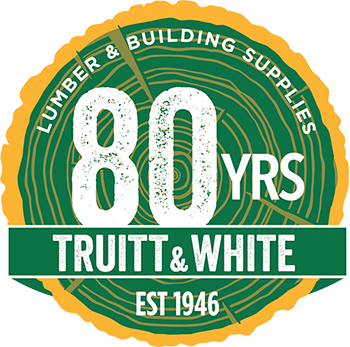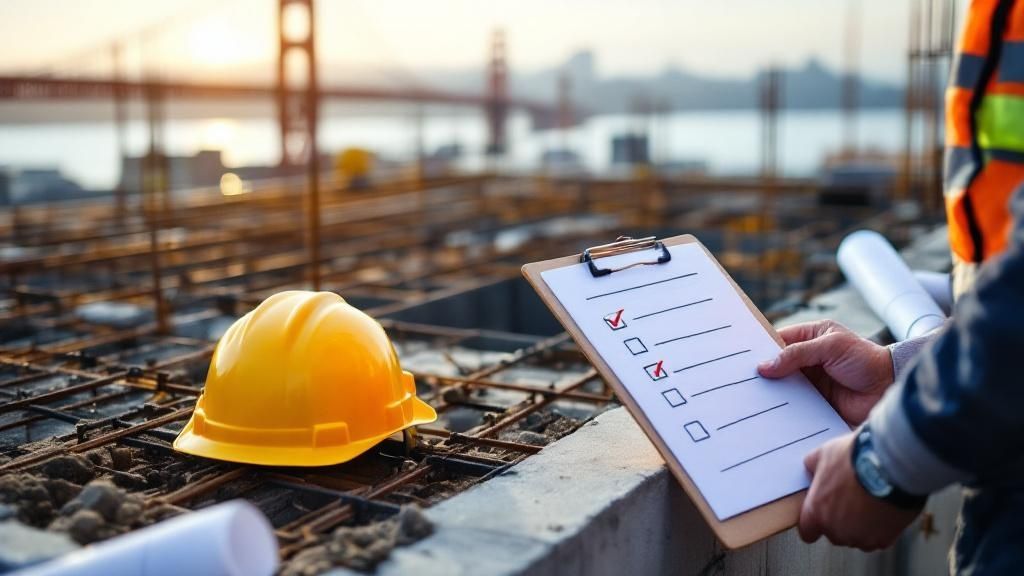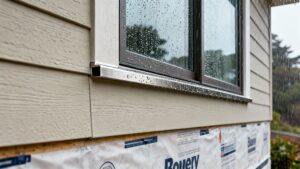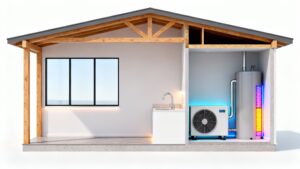In the competitive Bay Area construction market, a project's success is measured not just by its completion, but by its enduring quality. Delivering a structure that stands up to regional demands—from seismic activity in San Francisco to specific municipal codes in Berkeley and Oakland—requires a systematic, proactive approach to quality management.
A robust construction quality control checklist is the cornerstone of this system, transforming abstract standards into actionable, verifiable tasks. It ensures every phase, from foundation pour to final walkthrough, meets rigorous benchmarks for safety, durability, and client satisfaction.
This guide provides a comprehensive construction quality control checklist designed for builders, contractors, and architects who refuse to compromise on excellence. The foundational principle behind any effective quality control system is the use of comprehensive checklists. To understand the universal value of such systematic verification, consider the importance of using checklists in drone operations, where meticulous pre-flight checks prevent costly failures. The same discipline applies on a job site.
By implementing the steps outlined here, you can minimize rework, prevent budget overruns, and build a reputation for delivering superior results. This checklist will serve as your roadmap to building excellence in the Bay Area, ensuring every project component is executed correctly the first time.
1. Foundation and Structural Integrity Inspection
A building's safety, longevity, and performance depend entirely on its underlying structure. A comprehensive Foundation and Structural Integrity Inspection is the most critical first step in any construction quality control checklist, as it verifies that the core load-bearing elements are built to last.
This process involves a meticulous examination of foundation systems and structural components to ensure they align with engineering designs and local building codes. High-profile structural issues in San Francisco underscore the non-negotiable importance of this phase. Ensuring the long-term safety of a building starts with a rigorous assessment of its fundamental components, including the structural verification of roofs and all other load-bearing systems.
Key Inspection Areas for Foundation and Structure
Effective structural inspection is a continuous process, not a single event. Here are actionable steps to integrate into your Bay Area construction workflow:
- Phased Inspections: Schedule inspections before, during, and after concrete pours. Check rebar placement, size, and tying before concrete is poured.
- Certified Material Testing: Use accredited, third-party labs to test concrete cylinders for compressive strength and to verify the grade of steel rebar, especially for projects in seismic zones.
- Immediate Documentation: Equip site supervisors with digital tools to document every measurement and test result. Photographic evidence should be time-stamped and attached to daily reports.
- Establish Clear Criteria: Define and communicate acceptance criteria for every structural element, including tolerances for foundation dimensions and rebar spacing, as outlined by the American Concrete Institute (ACI).
Key Insight: For complex Bay Area projects, engaging a third-party structural engineering firm for a peer review of the plans can identify potential issues before they become costly on-site problems. This proactive step provides an invaluable layer of risk mitigation.
The following infographic illustrates the core workflow for verifying structural components on-site.
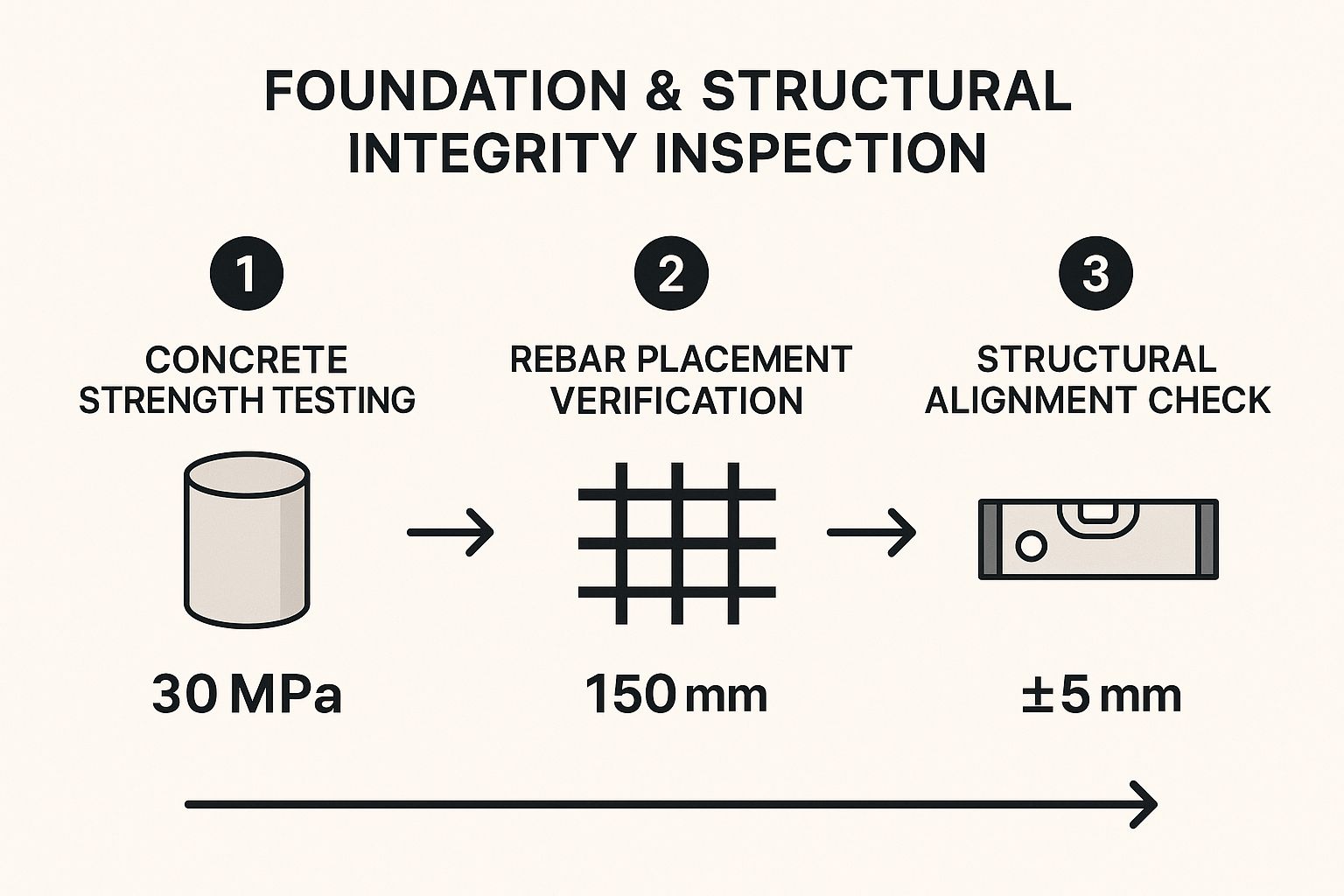
This streamlined process ensures that each critical structural parameter is systematically verified against project specifications, preventing minor deviations from compounding into major structural flaws.
2. Material Quality Verification and Testing
The quality of a finished structure is directly tied to the quality of its materials. A systematic process for Material Quality Verification and Testing is a non-negotiable part of any construction quality control checklist.
This process confirms that all materials, from framing lumber to finishing fixtures, meet specified standards, design requirements, and local building codes. Sourcing long-lasting, durable materials from a trusted supplier like a local Berkeley lumberyard is the first line of defense against premature failure.
Subpar materials can lead to costly repairs and significant safety risks. For example, selecting the right windows and doors for the Bay Area's microclimates is crucial for energy efficiency and longevity.

Key Areas for Material Inspection
Effective material verification is a continuous cycle of documentation, inspection, and testing. Here are actionable steps for your project:
- Establish Approved Vendor Lists: Pre-qualify and maintain a list of trusted suppliers, like local Bay Area lumberyards known for consistent quality. This minimizes the risk of receiving substandard materials.
- Create Material Receiving Checklists: Develop detailed checklists for incoming deliveries. Visually inspect for damage, verify quantity, and cross-reference material certificates against the purchase order.
- Maintain Proper Storage Conditions: Ensure materials like cement, lumber, and insulation are stored in environments that protect them from the Bay Area's moisture and UV radiation.
- Centralize Test Documentation: All material test reports and inspection records should be stored in a centralized, accessible digital database, which is essential for audits and final project handover.
Key Insight: Standardize the "hold point" process. A hold point is a mandatory verification step where work cannot proceed until a specific material has been formally inspected and approved by the quality control team.
3. Workmanship Standards and Trade Inspections
Beyond sound materials lies the execution quality that clients see and feel. A robust system for evaluating Workmanship Standards and Trade Inspections ensures the final product meets the aesthetic and performance expectations defined in the project scope.
This process involves a detailed review of installation quality across all trades, from framing and drywall to electrical and painting. The difference between a standard project and an exceptional one often comes down to the level of finish.
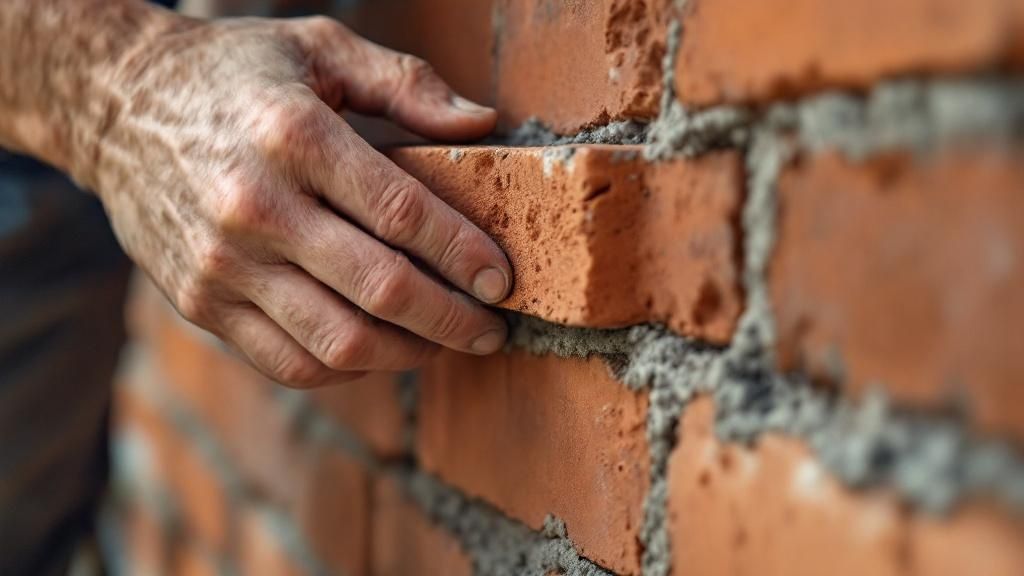
Key Areas for Workmanship Inspection
Maintaining high workmanship standards requires a proactive, hands-on approach. Here are actionable steps for your construction quality control checklist:
- Develop Visual Standards: Create a "quality look-book" with photos distinguishing acceptable from unacceptable work for tasks like paint finishes or tile grout lines. This removes ambiguity and becomes a powerful training tool.
- Conduct Regular Toolbox Talks: Dedicate short meetings on-site to quality. Discuss upcoming tasks, review common defects, and reinforce the project's quality expectations directly with craft workers.
- Implement Quality Scorecards: Evaluate each trade contractor's performance using a standardized scorecard. This data helps in making informed decisions for future projects.
- Provide Immediate Feedback: Empower supervisors to provide real-time feedback and document defects as they are discovered. For insights into top-tier equipment that can elevate project quality, explore this tool spotlight from Truitt & White.
Key Insight: Implement a peer review system where skilled craft workers from one trade inspect the work of another. A roofer might spot potential water intrusion issues around a newly installed skylight, fostering a culture of collective ownership over project quality.
4. Safety and Code Compliance Verification
A project's success is measured by its adherence to legal and safety mandates. Safety and Code Compliance Verification is a non-negotiable part of any construction quality control checklist, ensuring the project protects workers and future occupants.
This process involves a continuous assessment of all site activities against OSHA regulations and local building codes in jurisdictions like Oakland or San Francisco. The consequences of non-compliance can be devastating, ranging from stop-work orders to severe fines.
Key Areas for Safety and Compliance
Effective safety and code compliance is an ongoing discipline. Here are actionable steps to integrate into your workflow:
- Maintain Current Code Libraries: Designate a team member to track amendments to the California Building Code and local ordinances. Provide field teams with instant access to the latest versions.
- Proactive Inspector Relationships: Establish a professional, communicative relationship with local building inspectors. Invite them for pre-inspection walkthroughs to clarify expectations and address potential issues.
- Rigorous Safety Documentation: Document everything, including daily safety briefings, worker training certifications, and equipment inspection logs. A detailed fire safety inspection checklist is paramount for identifying risks.
- Strategic Inspection Scheduling: Integrate municipal inspection milestones directly into your master project schedule. This prevents bottlenecks and keeps crews productive.
Key Insight: Create a master compliance matrix at the project's outset. This document should list every required permit and inspection, along with its due date, responsible party, and current status, providing a clear dashboard for managing compliance.
5. Documentation and Record Keeping
In modern construction, what isn’t documented effectively doesn’t exist. A systematic approach to Documentation and Record Keeping forms the backbone of any credible construction quality control checklist.
This process involves the meticulous collection, organization, and maintenance of all project-related documents, ensuring accountability and a clear historical record. This structured approach, like that detailed in the construction process in San Francisco, turns paperwork from a burden into a powerful project management tool.
Key Areas for Documentation
Effective documentation is proactive, not reactive. Integrating these steps will create a reliable project archive:
- Implement Cloud-Based Document Management: Use a centralized, cloud-based platform to store all documents, ensuring everyone has real-time access to the latest versions of plans and reports.
- Establish Clear Naming Conventions: Create and enforce a standardized file naming convention (e.g.,
ProjectName_Date_DocumentType_Version.pdf) to make critical information instantly searchable. - Use Mobile Apps for Field Data Collection: Equip field teams with mobile apps to capture photos, fill out inspection forms, and log daily reports directly from the job site. This eliminates double-entry and reduces errors.
- Conduct Regular Audits and Backups: Schedule weekly audits to ensure all required documentation is present and correctly filed. Automate backups of your digital document repository to protect against data loss.
Key Insight: Treat every document as a legally binding record. Daily reports, RFIs, and email communications can become critical evidence in a dispute. Train your team to write clearly, factually, and professionally in all project communications.
6. Environmental and Sustainability Controls
Modern construction now carries a significant responsibility for environmental stewardship, especially in the sustainability-focused Bay Area. Environmental and Sustainability Controls are an integral part of a contemporary construction quality control checklist.
This process involves monitoring practices designed to manage waste, control pollution, and adhere to green building standards like those set by the California Energy Commission. By prioritizing green building materials and methods, projects can deliver lasting value to clients and the community.
Key Areas for Sustainability Checks
Effective environmental control requires a proactive and documented strategy. Here are actionable steps for your checklist:
- Implement a Waste Management Plan: Create a detailed plan for sorting and diverting construction debris. Set up labeled bins for recyclables, salvageable materials, and non-recyclable waste.
- Establish Pollution Prevention Protocols: Implement measures to control site runoff and dust. Use silt fences to prevent soil erosion from polluting local waterways.
- Monitor Resource Consumption: Actively track water and energy usage during construction. Install sub-meters to identify areas of high consumption and enforce conservation practices.
- Ensure Proper Material Sourcing: Verify that materials meet sustainability criteria, checking for recycled content, low-VOC certifications, and sustainably harvested wood (FSC certified).
Key Insight: Engage a LEED Accredited Professional (AP) during the pre-construction phase. Their expertise can help align the design and construction methods with specific sustainability goals, streamlining the certification process.
7. Systems Integration and Commissioning
A modern building is a complex network of interconnected systems. Systems Integration and Commissioning is the systematic process of verifying that all mechanical, electrical, and plumbing (MEP) systems perform according to the design intent.
This phase moves beyond individual component checks to ensure seamless interaction for optimal performance and energy efficiency. Proper commissioning is a cornerstone of any modern construction quality control checklist, transforming a collection of parts into a high-functioning, unified whole.
Key Areas for Systems Commissioning
Effective commissioning requires a forward-thinking, documented approach. Here are actionable steps to integrate into your projects:
- Begin Planning During Design: Integrate a commissioning authority into the design phase to review plans for feasibility and maintainability. This catches conflicts before they become costly field changes.
- Develop Comprehensive Testing Protocols: Create detailed scripts for functional performance tests (FPTs), guided by standards from organizations like ASHRAE. These should outline test procedures and acceptance criteria.
- Document All System Dependencies: Use a commissioning matrix to map interactions between systems, such as how the building automation system (BAS) controls lighting based on occupancy sensor data.
- Schedule Sufficient Testing Time: Rushing commissioning leads to unresolved issues. Allocate dedicated time in the project schedule for testing, adjusting, and re-testing systems.
Key Insight: For mission-critical facilities, engaging an independent, third-party commissioning agent (CxA) is invaluable. A CxA provides unbiased verification, acting solely on behalf of the owner to ensure all systems meet performance requirements.
The following flowchart outlines the essential stages of a successful commissioning process.
This structured workflow ensures that from design to handover, every system is methodically checked and its performance optimized.
8. Quality Assurance Program Management
A proactive quality assurance program drives a successful construction project. Quality Assurance Program Management involves the comprehensive planning, implementation, and continuous improvement of all quality processes.
It ensures every team member, from project managers to subcontractors, understands their role in delivering a final product that meets or exceeds all standards. This transforms quality from a line item on a checklist into a core value.
Key Areas for Program Management
Effective quality assurance is about embedding a quality-first mindset into the project's DNA. Here are actionable steps:
- Align Objectives with Project Goals: Define clear, measurable quality objectives that support the project’s overall goals, such as schedule adherence and budget control.
- Establish Clear Roles and Responsibilities: Create a quality management organizational chart. Clearly define who is responsible for what, from material verification to final commissioning.
- Invest in Continuous Training: Provide regular training for all personnel on quality standards, new techniques, and the use of quality management software.
- Use Technology to Streamline Processes: Implement a digital Quality Management System (QMS) to manage documentation, track non-conformance reports, and analyze performance data.
Key Insight: Treat your quality assurance program as a living system. Schedule quarterly reviews with key stakeholders to analyze performance metrics, discuss lessons learned from Bay Area projects, and update procedures.
Frequently Asked Questions (FAQs)
1. What is the most critical part of a construction quality control checklist?
The most critical part is the Foundation and Structural Integrity Inspection. Flaws in the foundation can compromise the entire structure's safety and longevity, leading to costly and sometimes impossible repairs. Getting this phase right is non-negotiable for any project, especially in seismic regions like the Bay Area.
2. How can I ensure the lumber and building materials I receive on-site are high quality?
Establish a relationship with a reputable local supplier, such as a Berkeley building materials provider known for quality. Upon delivery, use a receiving checklist to visually inspect materials for defects, verify certifications (like FSC for wood), and confirm that specifications match your purchase order before accepting them.
3. How do I manage quality control with multiple subcontractors on a job site?
Set clear expectations in your contracts and conduct a pre-construction meeting to review quality standards. Use visual aids, regular "toolbox talks" on quality, and standardized inspection forms for each trade. This ensures everyone is aligned with the project's quality goals from the start.
4. What's the best way to keep track of all the paperwork for a project in Oakland or Berkeley?
Use a cloud-based document management system. This centralizes all plans, permits, inspection reports, and photos, making them accessible to your entire team in real-time. This is crucial for staying organized and compliant with local regulations.
5. How does a quality control checklist help with Bay Area-specific challenges like seismic codes?
A good checklist incorporates specific verification points for seismic requirements. This includes checks for proper rebar grade and placement, shear wall nailing patterns, and the use of specified seismic hardware. This ensures your project is built to withstand local geological demands and passes stringent municipal inspections.
Build with Confidence in the Bay Area
Navigating the complexities of a modern Bay Area construction project is a monumental task, but it’s one that can be managed with precision and a systematic approach. The comprehensive construction quality control checklist detailed in this guide is a strategic framework designed to transform your project management from reactive to proactive.
By diligently implementing these checks, you move beyond simply fixing errors and start preventing them from ever occurring. It involves rigorous material verification, demanding workmanship inspections, and meticulous documentation—all tailored to the high standards of the Bay Area market.
Key Takeaways for Immediate Implementation
To distill these extensive checklists into actionable steps, focus on these core principles:
- Integrate Early and Often: Quality control is not a final step. It must be woven into the project lifecycle from pre-construction planning through to final handover.
- Empower Your Team: A quality culture thrives when every team member understands their role in maintaining standards. Provide clear guidelines and regular training.
- Leverage Technology: Modern construction management software can automate reminders, store photographic evidence, and streamline reporting, improving the efficiency of your quality process.
- Documentation is Your Defense: In a world of complex contracts, your records are your best defense. A well-maintained log of inspections provides a transparent and verifiable history of project quality.
The ultimate value of a robust construction quality control checklist extends far beyond the physical structure you are building. For professionals in Berkeley, Oakland, and across the Bay Area, a demonstrable commitment to quality is a powerful competitive advantage.
Executing a flawless construction quality control checklist starts with sourcing materials you can trust. For contractors, builders, and architects in the Bay Area, Truitt and White has been the reliable partner for premium building supplies for over 75 years. Ensure your project is built on a foundation of quality. Visit our Berkeley showroom for expert advice. https://truittandwhite.com/connect-with-us

